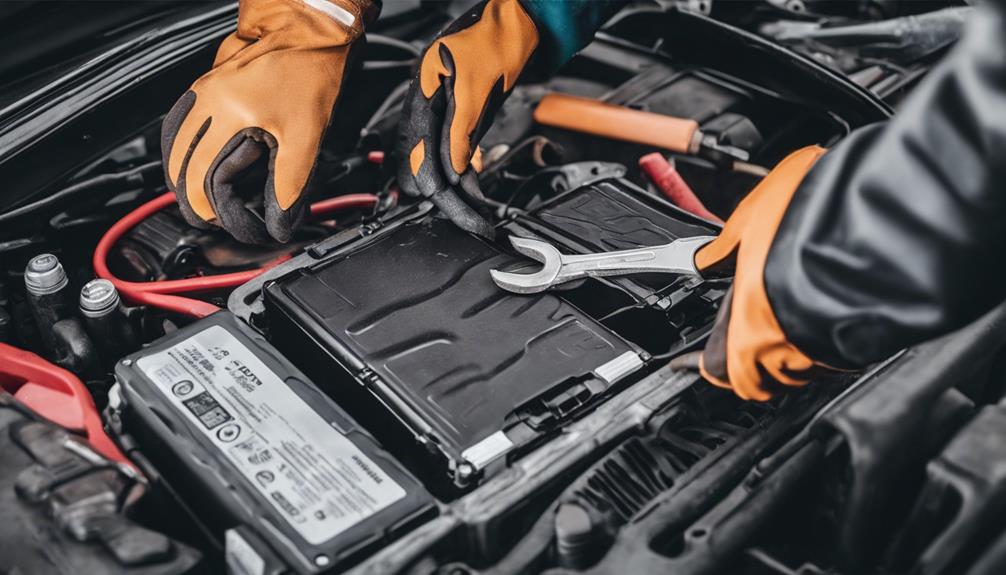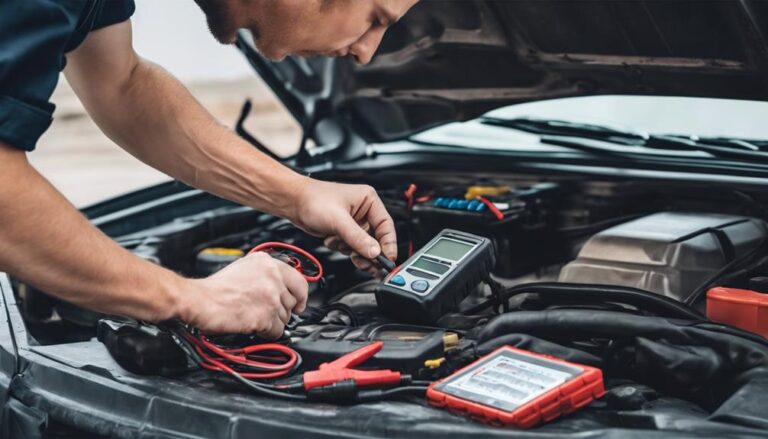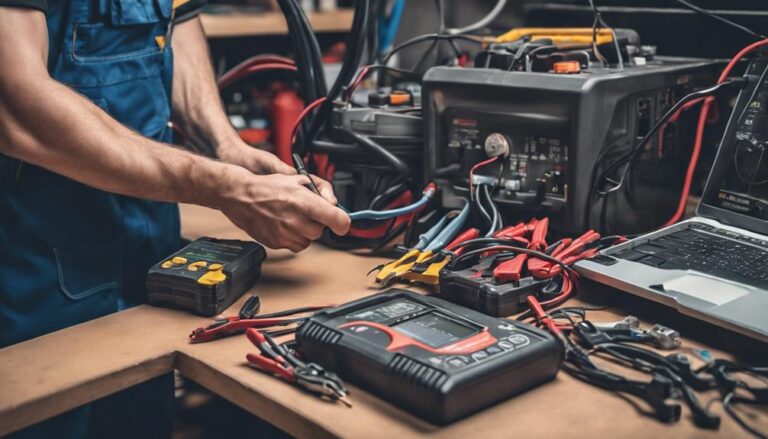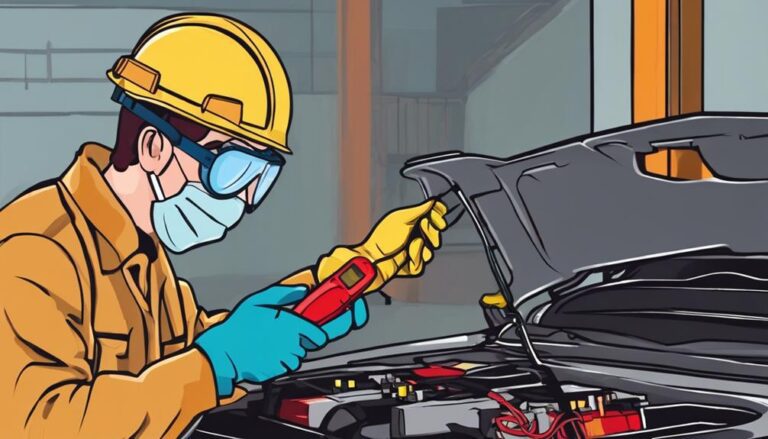Safely Replacing Your Car Battery: A Step-by-Step Guide
Imagine the hum of your engine fading as you prepare to tackle the task of replacing your car battery. As you lift the hood, the sight of the old, worn-out battery prompts you to take action.
But how do you ensure a smooth transition without a hitch? Let's walk through the intricacies of this process, step by step, ensuring your vehicle's heart receives the care it deserves.
Key Takeaways
- Identify battery terminals correctly for safe replacement
- Disconnect old battery securely, prioritizing negative terminal
- Install new battery carefully, checking connections
- Reconnect terminals in the correct order with proper tools and precautions
Identifying Battery Terminals
To correctly identify the terminals of your car battery, start by locating the red cover marking the positive terminal for easy recognition. The positive terminal is crucial for providing power to the vehicle's electrical system.
Typically, the negative terminal is connected to the engine block. Ensuring you correctly identify the terminal polarity is essential before proceeding with any electrical connections.
Identifying the terminals accurately will help you avoid errors during the battery replacement process. Take a moment to familiarize yourself with the layout and markings on the battery to confidently distinguish between the positive and negative terminals. This step is foundational to the successful replacement of your car battery.
Disconnecting Old Battery Safely
When disconnecting the old battery safely, first ensure that you have the necessary tools and protective gear readily available. Start by using a ratchet or wrench to loosen the terminal clamp on the negative terminal. This step is crucial in preventing any electrical issues. Once the negative terminal is disconnected, carefully proceed to do the same with the positive terminal. Remember to remove any restraints holding the battery in place before attempting to pull it out. It's important to handle the old battery properly to avoid any accidents or damage during the replacement process. Safely set the old battery aside until you are ready to dispose of it. Proper battery disposal is essential for the environment, so consider recycling centers or auto parts stores that accept old batteries. Always prioritize safety precautions and environmental impact when handling car batteries.
| Safety Precautions | Environmental Impact |
|---|---|
| Disconnect negative terminal first | Proper battery disposal is crucial |
| Use tools to loosen terminal clamps | Recycling old batteries helps the environment |
| Remove restraints before pulling out battery | Avoid environmental damage by handling batteries correctly |
| Handle old battery safely to prevent accidents | Choose responsible disposal methods for old batteries |
Removing Old Battery From Vehicle

Carefully inspect the battery compartment for any additional restraints before proceeding with the removal process. Start by disconnecting the negative terminal first to prevent electrical shock or short circuits. Use a ratchet to loosen the clamp securing the negative terminal, ensuring a safe removal. Next, disconnect the positive terminal after the negative one to avoid any potential accidents.
Once the terminals are disconnected, remove any restraints that are holding the battery in place under the hood. This will facilitate the extraction process. Carefully pull the old battery out from its location, ensuring it doesn't tip over or spill any acid. Set the old battery aside for proper disposal or recycling to minimize its environmental impact.
Proper disposal of the old battery is crucial as it contains materials that can be harmful if not handled correctly. Recycling old batteries helps reduce waste and prevent pollution, making it an environmentally responsible choice.
Installing New Car Battery
Inspect the new battery for any defects or damage before proceeding with the installation process. Once confirmed, follow these steps for installing your new car battery:
- Secure the Battery: Place the new battery in the battery tray and fasten the battery restraint to hold it firmly in place.
- Connect Cables: Attach the positive cable first, followed by the negative cable, ensuring they're tightly secured to the appropriate terminals.
- Final Checks: Double-check all connections, ensuring they're secure and free of debris before starting your vehicle.
For optimal battery performance, remember these maintenance tips: regularly check the battery for corrosion, keep the terminals clean, and test the battery's voltage periodically.
When it's time to dispose of your old battery, follow proper guidelines for recycling or disposal to protect the environment. By following these steps and guidelines, you can safely and effectively install your new car battery while maintaining its longevity and efficiency.
Reconnecting Battery Terminals
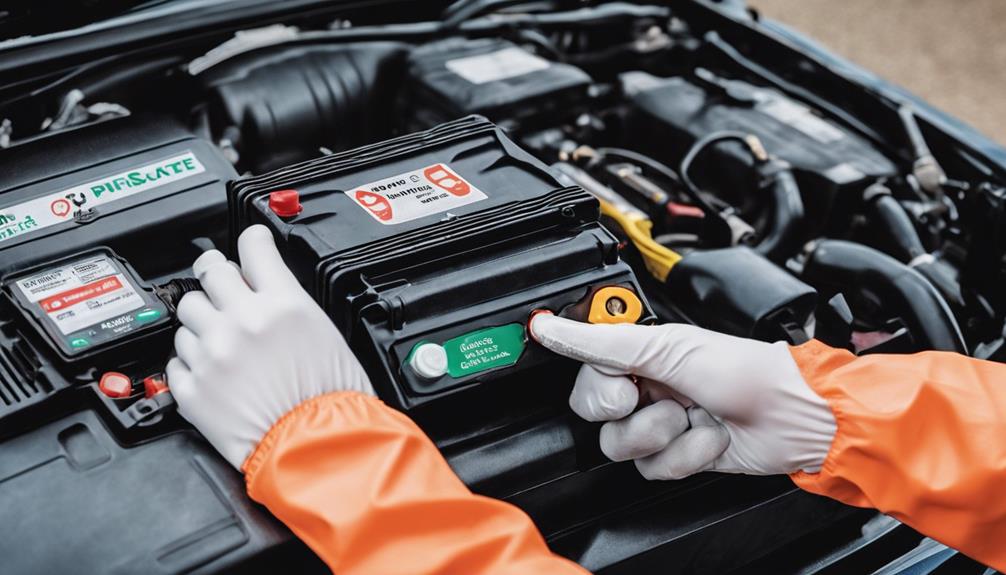
To ensure a reliable electrical connection, start by securely attaching the positive terminal first when reconnecting the battery terminals. Terminal maintenance is crucial; ensure the terminals are clean and free of corrosion before reconnection. Cleaning them with a terminal cleaner or a mixture of baking soda and water can help maintain a good electrical connection.
Safety precautions are essential; wear gloves and eye protection to prevent any accidents while working on the battery. Once the terminals are clean, proceed to attach the positive terminal, followed by the negative terminal. Use a wrench to tighten the terminal connections securely, ensuring there are no loose connections that could lead to electrical problems.
Double-check the polarity to make sure the positive and negative cables are correctly attached to their respective terminals. After reconnecting the battery terminals, test the car's electrical systems to ensure everything is functioning properly before closing the hood. By following these steps carefully, you can safely and effectively reconnect your car battery terminals.
Frequently Asked Questions
How Do You Replace a Car Battery Step by Step?
When replacing a car battery, start by parking on a flat surface, turning off the engine, and engaging the parking brake. Remove the negative cable first, then the positive. Clean terminals, install the new battery securely, and test.
How to Be Safe When Changing Car Battery?
To be safe when changing your car battery, prioritize safety precautions and proper battery disposal options. Wear protective gear, avoid sparks, and follow guidelines meticulously. Always handle batteries with care to prevent accidents and ensure safety.
Which Battery Terminal Do I Replace First?
Before replacing your car battery, always disconnect the negative terminal first. This terminal connection is crucial for safety precautions. By starting with the negative terminal, you can minimize the risk of electrical mishaps during the process.
What Not to Do When Changing a Car Battery?
When changing a car battery, avoid common mistakes like reconnecting cables incorrectly or touching both terminals simultaneously. Follow safety precautions by cleaning terminals, using gentle force, and recycling the old battery properly to prevent damage and pollution.
Conclusion
Now that you have successfully replaced your car battery following the step-by-step guide, your vehicle is ready to hit the road with renewed power.
Remember, a well-maintained battery ensures smooth starts and reliable performance. So, take pride in your accomplishment and drive confidently knowing you've taken care of your car's heart.
As they say, a healthy battery is the key to a smooth ride!

